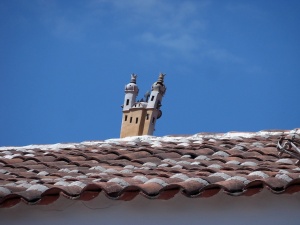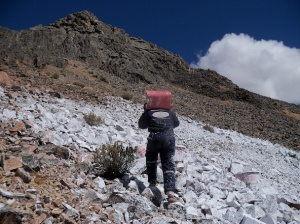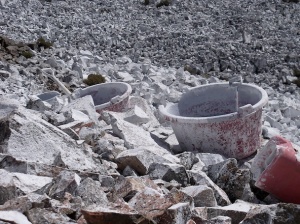Ayacucho: When Salamon Parco was the same age as his son, Wilmer, 5, a river ran through this valley. It watered the alpaca pastures around Licapa, Parco’s village, 100 kilometres west of the town of Ayacucho in Peru. But the glacier at Chalon Sombrero disappeared completely 20 years ago, and with it the river. All that is left is a black rocky summit above a worn channel where a river once ran.

Now, Parco and his friend Geronimo Torres spend every morning painting the black mountain white, hoping to bring back the glacier on which 900 people depend.
We take a night bus from Lima to Ayacucho, a very pretty colonial town that’s built on far more ancient foundations – the remains of what may be the oldest South American civilization, dating back more than 15,000 years are located in nearby Pikimachay. From here, we stock up on provisions for the day (bread, jamon y queso) and drive into the mountains.


Licapa, at 4200 meters up, is an Andean village of 200 people whose livelihoods are based around farming alpaca, the domesticated camelid of South America. Alpaca are farmed for their meat and also for their fine wool, which is used in clothing and tapestries. This part of Peru is one of the poorest in the country and was hit particularly hard in the 1980s and early ’90s during a decade of terrorism led by the Shining Path, a violent Maoist guerilla group which had its base in Ayacucho.

The farmers around here, who speak Quechua, the ancient language of the Incas, have spent the past 20 years trying to rebuild their broken communities, homes and lives, helped by various government schemes. But climate change is against them. Chalon Sombrero, at just 5000 metres above sea level, is one of hundreds of glaciers expected to vanish by 2015 because of global warming.

“In the next 5-10 years, all the glaciers below 5500 metres will have gone,” says tropical glaciologist Lonnie Thompson of the Ohio State University, who has been taking core samples from Peru’s glaciers for the past 40 years. “The Quelccaya glacier in southern Peru, which is the world’s largest tropical ice-cap, retreated at 6 metres per year during the first 15 years we studied it (to 1990), and then 60 metres per year in the last 15 years. That’s a ten-fold increase in speed.”

Warmer air temperatures are fast melting the glaciers and being helped by the rise in the zero-degree isotherm, which means that more of the precipitation in the Andes is falling as rain rather than snow. “Rain on a glacier is the fastest way to melt it,” Thompson says. And as the glaciers go, so too the lakes at their bases on which thousands of rural people depend. Peru’s total glacier-covered area shrunk from 2,000 square kilometres to 1,500 square kilometres over the last 30 years. That represents an estimated seven billion cubic meters of water – the equivalent of 10 years of water consumption in Lima.

It doesn’t often rain here, and what rain does fall is confined to January and February. The rest of the year, the high-alpine grasslands rely on glacial meltwater and, in its absence, turn yellow and die. More than 100 people have already left Licapa because they cannot feed their families, migrating to shanty settlements around Lima. Parco, with a wife and three young children, is considering the same. “But my home is here. What would I do in the city. I need to try and make it work here first,” he says.

They began painting the mountain in May and by September had turned 3 hectares of black rock white, in a remarkable experiment that is backed by $200,000 in prize money from a 2009 World Bank climate change adaptation competition. The money, which the experiment’s conceiver Eduardo Gold says he has yet to receive, will be used to build a factory in Licapa to produce the lime paint (calcium hydroxide solution, Ca(OH)2) that Parco and Torres are using to whiten the mountain. On the dusty earth sections between rocks, the painters will mix egg-white with the lime to enhance its stickiness.

Gold is an unpleasant fellow and possibly the rudest man I have yet interviewed when I meet him in Lima. Nevertheless, curiosity compels me to visit his experiment, a 12-hour journey south of Lima. Despite our arrangement to meet and my pleading with him to stay, he drives off, beer in hand, the moment we reach Chalon Sombrero, and then tosses the empty can onto the pristine mountainside. Instead, we seek out Parco and Torres.
It’s Gold’s second attempt at cooling a mountain top. In 2005, he experimented on Chaupijanca glacier, by burying a tonne of dry ice (carbon dioxide) in the ice sheet. “The ice above the dry ice stayed there while the rest melted, but the experiment was too small scale,” Gold says, apparently unaware of the irony of mitigating global warming by adding carbon dioxide to the atmosphere.

The current experiment is based on the principle that a black body absorbs more heat than a white one. It’s a similar idea, albeit more complicated, to US Energy Secretary Steve Chu’s proposal to paint roofs white. By increasing the albedo (reflectivity) of the black rocks, using white paint, the mountain should be cold enough to retain the ice that forms on it – and eventually a glacier will form. That’s the hope, anyway.

There are plenty of sceptics, including Peru’s environment minister, Antonio Brack, who believes the money could be better spent on other climate mitigation projects. And Gold, who has no scientific qualifications, is also judged with some suspicion by agencies and public bodies.
Nevertheless, Parco is already seeing results. “In the day-time, the painted surface is 5 degrees C, whereas the black rock is 20C. And at night, the white surface falls to -5C,” he says. Ice now forms on the painted rocks over night, although it has melted by 10.30am. Now the race is on to get 7 hectares more painted before the onset of the hail in January, so that results can be seen in April.

The plan is to dig a small reservoir of water above the painted section and pump water up to it using a wind turbine, which will then be released during the night in a slow trickle over the paint, where it is hoped it will freeze. In time, the ice will build up and the process will be self-sustaining, because glacial conditions would be there: cold generates cold, Gold says.
Parco and Torres have 70 hectares to paint in total, a job they think will take 2 years. They started the paint job with two other men in May, but 15 days later, the other two dropped out because there was no money to pay them.

“We are still painting the mountain because it works, and because we have no choice,” Parco says. “If there is no glacier, then there is no water for us and we will have to move away.”
The hopes of a village cannot change the physical facts, though. “Painting the rocks won’t change the topography of the mountains there,” says Elizabeth Silvestre, scientific director at the National Meteorological and Hydrological Service (Senamhi) in Lima. “Glaciers are dynamic and have different properties of ice and snow, and they melt because of many reasons. I don’t think white paint can fix that,” she says.

Lonnie Thompson of the Ohio State University, who has been studying Peru’s glaciers for the past 40 years, says that ideas like painting the mountain or covering glaciers in sawdust, as another group is trying, may have some success in the short term in a local area, but they are not feasible over greater regions. “Nobody is going to paint the entire Andean chain white,” he says. What is needed now that the glaciers are disappearing, is man-made water storage to replace them. “This means a big programme of building dams and reservoirs, which is tricky in such an earthquake-prone zone, but necessary,” he says.
Building dams takes time and money, and it is unlikely that Parco’s remote village of Licapa will be prioritised for new water works in the next few years. Painting a mountain white may, however, produce enough ice in the next couple of years to buy the villagers time to adapt to a different livelihood. And prevent Parco’s family from being another household living on a sand dune outside Lima.
What a fascinating and bizarre idea! Unfortunately for Parco and Torres, it sounds like a fools errand to me; if only undoing atmospheric CO was as simple as a coat of paint. You mentioned the irony of Gold trying to use dry ice to cool the mountaintop, but did you also consider that the lime in the paint is made by baking limestone (CaCO3) to make quicklime (CaO) that is mixed with water to make the slaked Ca(OH)2? The main by product of that first reaction? Carbon dioxide…
yes, they produce a lot of CO2 making the lime from limestone but the lime paint will readsorb it all again, reforming limestone.
I wish them luck but doubt they can overcome higher air temperatures. This could be tried on very large areas by aerial spraying (think crop dusters). How much of the planet would we have to paint white to significantly incease the Earth”s albedo?
Logically I don’t see how this can work. They are hopeful that a little ice formation will start a glaciar growing. But the glacier was there, it was ice, it was white and it melted. Their new ice will also melt.
They really need to capture and store rain.